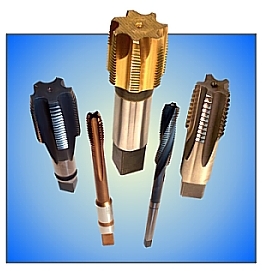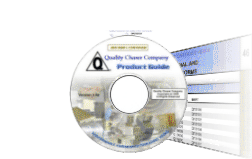

|
 |
|||||||
| Firth Brown Solid Taps | |
 |
Quality Chaser Company is pleased to announce an agreement to represent Firth Brown Tools.
Firth Brown has been manufacturing exceptional tooling in Cambridge, Ontario since 1921. Their tools are designed and engineered on-site under ISO 9001 quality certification guidelines. Primary products of the Firth Brown Company are solid high-speed steel pipe taps, nib taps, bent shank and spiral point taps. A variety of premium material options and surface treatments are also available. These special taps are used in applications such as automotive, lead-free brass valves and fittings, pipe and fastener couplings, construction grade nuts and other demanding applications where high production and superior performance are required.
You can submit a Request for Quote on
the E-Mail page, or...
Contact our Customer Service for quoting requirements and details.
|

Version 1.4 of Quality Chaser's colorful Product Guide on CD-ROM includes the most up-to-date information available, plus:
Visit the E-Mail page and request your free copy today. You can also download a copy right now from the Download page. |
 |
 |
Quality
Chaser offers
Oster
style dies in a
broad range of symbols and sizes.
Further information can be found on the Oster page, or get a copy of our Oster Product Guide in .pdf format from the Download page. ... or just give us a call. |
 |
|||
|
| |||
|
Solid adjustable
and collapsible taps are the most efficient method of tapping internal
threads. The taps are built exceptionally rugged to allow for high
production when tapping either parallel or tapered threads in diameters
larger than 1".
One outstanding feature of both the solid adjustable and collapsible style taps is their wide range and versatility. As a bonus, both styles of taps allow for diametrical adjustment ofapproximately 1/32" over or under the nominal chaser size. This featurealso allows you to compensate for chaser wear or reduction in size due to chaser resharpening. The economies of using this style of tapping equipment do not stop with the machine tool itself. Regrindable high-speed steel chasers are available to tap both open and blind holes. These precision chasers are ground to precise tolerances and are tailor made to suit your application. Our standard chasers are manufactured from M-2 high-speed steel. However, when the application warrants a higher grade of chaser, alternative materials, special heat treatments, and a wide variety of surface treatments (coatings) are available to enhance performance. Even though Quality Chaser Company does not manufacture any internal or external threading equipment like the taps mentioned here, we are recognized as a leader in providing the high speed steel or carbide tipped chasers used in these tools. Call us today with your application details. |
|||
Call for information. |